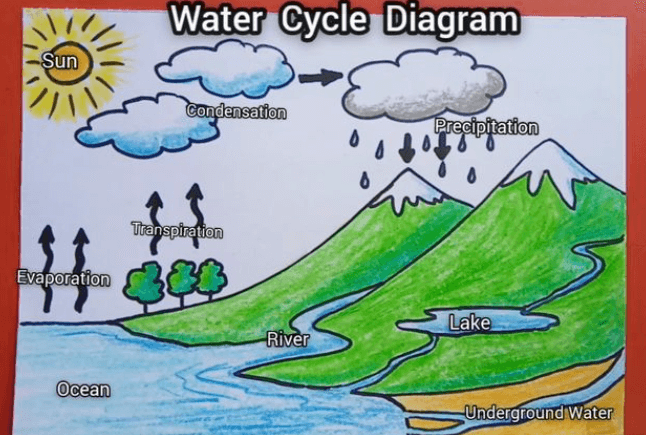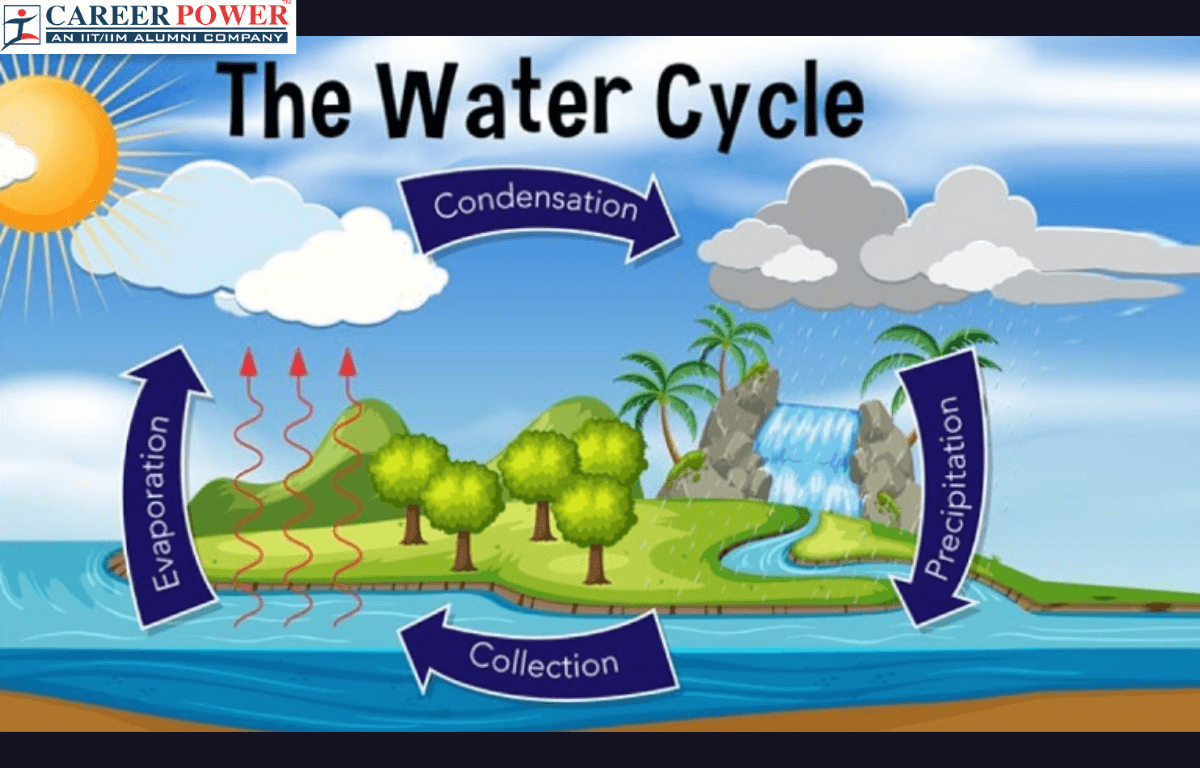The water cycle is like nature’s recycling system. The sun heats water from rivers, lakes, and oceans, turning it into vapor that forms clouds. When these clouds get heavy, they release rain, which flows into rivers and lakes, restarting the cycle. The whole process of the water cycle is like a continuous dance of water in our environment. Here we have explained the whole process of the water cycle with a diagram and model according to biology.
What is a Water Cycle?
The water cycle, also known as the hydrological cycle, is the continuous process by which water moves through the Earth’s atmosphere, land, and bodies of water. The water cycle is essential for maintaining Earth’s ecosystems and providing freshwater resources for human and natural systems. The stages involved in the process of the water cycle involve Evaporation, Condensation, Precipitation, Infiltration and Runoff, and Transpiration. It plays a crucial role in regulating the planet’s temperature and climate patterns. The whole cycle of the water cycle repeats continually, driven by solar energy, and plays a crucial role in maintaining Earth’s water supply, supporting ecosystems, and regulating the planet’s climate.
Key Stages of Water Cycle
- Evaporation: The process begins with the warming of water in oceans, rivers, lakes, and other bodies of water. This heat causes the water to change from a liquid to a vapor, forming water vapor in the atmosphere.
- Condensation: As the water vapor rises into the atmosphere, it cools and condenses to form tiny water droplets or ice crystals, creating clouds.
- Precipitation: When these water droplets or ice crystals combine and become too heavy, they fall back to Earth’s surface as precipitation, which can include rain, snow, sleet, or hail.
- Surface Runoff: Precipitation that falls on land can flow into rivers, streams, and eventually into the ocean. Some of it may also infiltrate into the ground to become ground to become groundwater.
- Transpiration: Plants absorb water through their roots and release it into the atmosphere through a process called transpiration.
- Sublimation and Melting: In colder regions, snow and ice can undergo sublimation (directly changing from ice to vapor) or melting (changing from ice to liquid) to re-enter the cycle.
Water Cycle Diagram
The water cycle, also known as the hydrochloric cycle, describes the continuous movement of water on, above, and below the Earth’s surface. This diagram illustrates how water is constantly cycling through the Earth’s atmosphere, land, and water bodies, maintaining a balance of water resources essential for life on our planet. Here’s an explanation of the key components in a typical diagram of the water cycle:

- Evaporation: In the first stage, heat from the sun causes water from bodies of water, like oceans, rivers, and lakes, to evaporate into water vapor. This vapor rises into the atmosphere.
- Condensation: As the water vapor rises higher in the atmosphere, it cools down and begins to condense into tiny water droplets, forming clouds. This process is similar to how moisture condenses on a cold glass on a hot day.
- Precipitation: When the water droplets in the clouds combine and become too heavy, they fall to the form of Earth’s surface as precipitation. This can take the form of rain, snow, sleet, or hail, depending on the temperature and atmospheric conditions.
- Surface Runoff: Precipitation that falls on the land can either be absorbed into the ground (infiltration) or flow over the surface as runoff. Runoff typically collects in streams, and rivers, and eventually flows into larger bodies of water, like oceans.
- Infiltration: Some precipitation soaks into the ground and replenishes underground water sources, such as aquifers. This water may later resurface through springs or be drawn up plants through a process called transpiration.
- Transpiration: Plants absorb water through their roots and release it into the atmosphere through tiny openings in their leaves. This contributes to the moisture in the air and is often included in the water cycle.
- Subsurface Flow: Water that infiltrates deeper into the ground can flow horizontally through underground layers of soil and rock. This subsurface flow eventually leads to the formation of underground reservoirs or moves toward bodies of water.
- Groundwater Discharge: Water from underground sources can resurface into streams, lakes, or rivers, contributing to surface water and contributing the cycle.
- Repetition: The cycle continues as the sun’s energy drives evaporation, condensation, and precipitation, ensuring a continuous movement of water between the Earth’s surface and the atmosphere.
Importance of Water Cycle
The water cycle is essential for sustaining life, regulating the environment, and supporting various human activities, making it a fundamental process for the Earth’s well-being. The water cycle is crucial for several reasons:
- Maintaining Ecosystem: It ensures a continuous supply of fresh water to support terrestrial and aquatic ecosystems, which are essential for biodiversity.
- Human Survival: The Water Cycle provides us with a renewable source of drinking water, necessary for human survival and agriculture.
- Climate Regulation: It plays a vital role in regulation and climate through processes like evaporation and condensation.
- Weather Patterns: The water cycle influences weather patterns, helping distribute heat around the planet and deriving weather systems.
- Natural Purification: It acts as a natural purification system by filtering and cleaning water as it moves through various stages of the cycle.
- Balancing Earth’s Water: The cycle helps balance the distribution of water across the planet, preventing excessive accumulation in one area and shortage in another.
- Supporting Agriculture: Agriculture depends on the availability of water, and the water cycle ensures a consistent supply for crop growth.



 50 Vegetables Name for Kids in English a...
50 Vegetables Name for Kids in English a...
 Food Chain: Definition, Types, Examples,...
Food Chain: Definition, Types, Examples,...
 Human Respiratory System: Definition, Di...
Human Respiratory System: Definition, Di...













